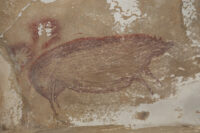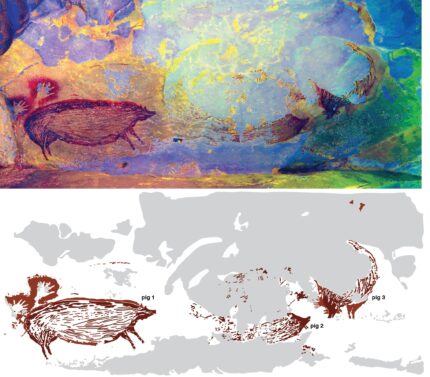 The image of a wild pig on a cave wall in Sulawesi, Indonesia, has been dated to 45,500 years ago, making it the oldest known cave art animal in the world. The life-sized Sulawesi warty pig (Sus celebensis) was painted in dark red ochre on the limestone wall of Leang Tedongnge cave. It was outlined in profile and filled in with lines and dashes. There are two hand stencils over its hindquarters.
The image of a wild pig on a cave wall in Sulawesi, Indonesia, has been dated to 45,500 years ago, making it the oldest known cave art animal in the world. The life-sized Sulawesi warty pig (Sus celebensis) was painted in dark red ochre on the limestone wall of Leang Tedongnge cave. It was outlined in profile and filled in with lines and dashes. There are two hand stencils over its hindquarters.
The pig was able to be dated thanks to a coralloid speleothem, a tiny calcite deposit known as cave popcorn, on one of its hind legs. Researchers chiseled the calcite from the wall and conducted uranium-series isotope analysis on extracted samples. The results found the pig was at least 45,500 years old, and very likely older given the time it must have taken for the speleothem to form.
The pig is in exceptional condition despite its advanced age. At least two other pigs are part of the rock art panel, but much of their pigment has  been lost from the natural exfoliation of the cave wall. The complete pig is on the left of the composition facing right towards the two partials who are facing off against each other. A fourth animal, of which very little remains to identify it, is above the pair. Researchers believe it may have been a fourth suid.
been lost from the natural exfoliation of the cave wall. The complete pig is on the left of the composition facing right towards the two partials who are facing off against each other. A fourth animal, of which very little remains to identify it, is above the pair. Researchers believe it may have been a fourth suid.
Evidence of human habitation of Sulawesi dates at least as far back as the Pleistocene, between 194,000 and 118,000 years ago. It’s not clear whether the folks who painted the pig were anatomically modern humans or another archaic human species like the Denisovans, but there are more than 300 caves and rock shelters with prehistoric wall art on the island. The Pleistocene rock art typically features animals native to Sulawesi — dwarf bovids and pigs — and hand stencils. Of these, pigs are the most popular subjects, present in over 80% of the representations.
The image from Leang Tedongnge, with a firmly established minimum age of 45.5 ka, would now appear to be the earliest known dated artwork in Sulawesi. It also represents the oldest reported indication for the presence of AMH on the island and perhaps in the wider Wallacean region (see below). We infer a similar minimum age estimate for the as-yet undated suid motifs visible on the rock art panel at Leang Tedongnge. As noted, together with the dated figure, these suid images seem to constitute a single narrative composition or scene—perhaps a depiction of social interaction between Sulawesi warty pigs. Furthermore, as far as we have been able to ascertain, the securely dated painting of a Sulawesi warty pig at Leang Tedongnge would now seem to be the world’s oldest surviving representational image of an animal. In addition, this dated depiction of an endemic Wallacean suid may also constitute the most ancient figurative artwork known to archaeology.
In Bahasa Indonesia, their main lanuage, “babi” means pig (from Malay ‘babi’, Proto-Austronesian *babuy).
As a teenager I traveled in Indonesia (Java, Eastern Borneo/Kalimantan and Bali), i.e. notably with a “Susan” from England, a.k.a. ‘Susi Babi’ :yes:
——-
PS: What I also could report is that ‘Nasi’=Rice, ‘Bami’=Noodles, ‘Goreng’=fried –with ‘Susi’ or without– unfortunately, nowadays, in main parts of Indonesia without
Such a wonderful find. It goes to our search to discover the extent to which our anatomically modern ancestors had the same minds as us.
Clearly at this point they did.
Social interaction?!? 😮 –From a meat curation point of view, I’d have a certain idea what the “two hand stencils over its hindquarters” might stand for.
From “Die vollständigste Naturgeschichte des In- und Auslandes” (1845), the ‘Most Complete Natural History Domestic and Abroad’, plate 34, “Das Schwein von Celebes” (i.e. the “pig of Sulawesi”, or -in Latin- “sus celebensis”):
—-
upload.wikimedia.org/wikipedia/commons/2/25/Sus_celebensis.PNG
—-
For “cave”, see: en.bab.la/dictionary/indonesian-english/liang [“bab” — hihi], of which the term “Leang” might be its Sulawesi variant. Contrastingly, the Latin term ‘sus’ is synonym to ‘porcus’. The –seemingly abusive– Dutch term ‘Babism’, however, from Indon. ‘babi’ (for pig) + ‘-ism’, is –as disturbing as it reads– “a pantheistic religion founded by Mirza Ali Mohammed”:
—-
“The Báb” — ..born Siyyid `Alí Muḥammad Shírází, 1819 – 1850) was the founder of “Bábism”, and one of the central figures of the Baháʼí Faith. He was a merchant from Shiraz in Qajar Iran who, in 1844 at the age of 25, claimed to be a messenger of God. He took the title Báb (باب), meaning “Gate” or “Door” [i.e. particularly not ‘sus’], a reference to the deputy of the promised Twelver Mahdi or al-Qá’im. He faced opposition from the Persian government, which eventually executed him and thousands of his followers, known as Bábís. “The Báb” composed numerous letters and books in which he stated his claims and defined his teachings with some roots in Shaykhism and Hurufism, using many numerical calculations. He introduced the idea of He whom God shall make manifest, a messianic figure who would bring a greater message than his own. To Baháʼís, the Báb fills a similar role as Elijah or John the Baptist: a predecessor or forerunner who paved the way for their religion. Baháʼu’lláh, the founder of the Baháʼí Faith, was a follower of the Báb and claimed in 1863 to be the fulfillment of the Báb’s prophecy, 13 years after the Báb’s execution.
—-
“Bacon Found to be Oldest Menu Item in the World.”
People,
This is UTTERLY ASTONISHING! That there were humans on the opposite ends of the earth ~50000 years ago painting in caves in an identical style (these pigs would be stylistically perfectly at home in Chauvet cave) and including HAND STENCILS just absolutely blows me away. I NEVER would have expected this.
Sincerely yours,
Tristram